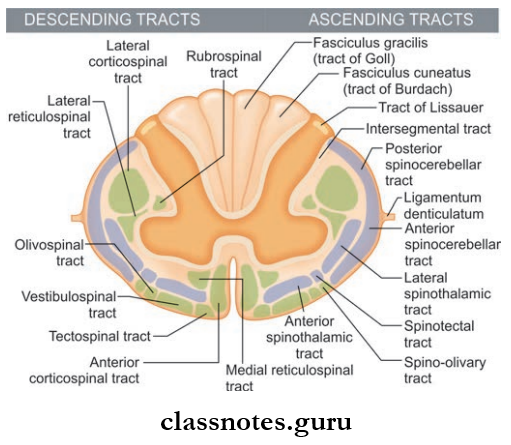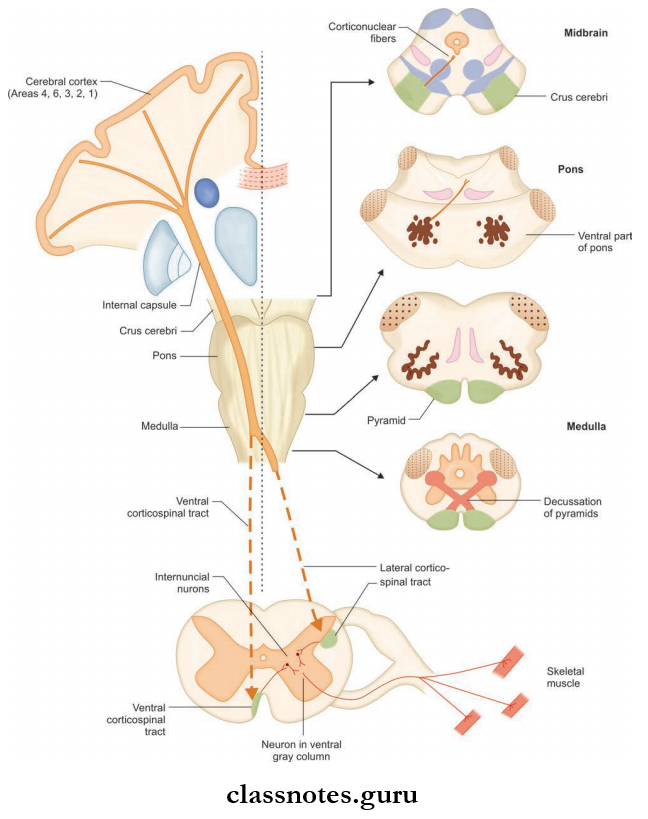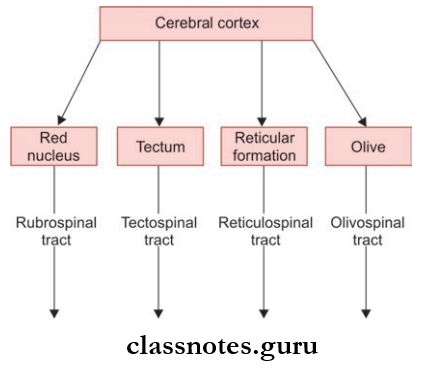Spinal Cord Question And Answers
Question 1. Write a short note on the laminar organization in the spinal cord.
Answer:
Laminar Organization In The Spinal Cord

- In thick section, neurons of the spinal cord appear to have a laminar arrangement
- Starting from tip of the dorsal horn towards the vertical horn ten layers are recognized
- These Are As Follows:
- Lamina 1: Corresponds to posteromarginal nucleus
- Lamina 2: Corresponds to substantia gelatinosa
- Lamina 3 And 4: Corresponds to nucleus proprius
- Lamina 5 and 6: Corresponds to the base of the dorsal column
- Lamina 7: Occupies the territory between dorsal and ventral horns and contains cells that function as interneurons. Nucleus dorsalis, intermediolateral, and intermediomedial are clear cell columns recognized within this lamina
- Lamina 8: Corresponds to ventral horn in thoracic segments
- Lamina 9: Includes a lateral group of nuclei of the ventral horn, supply skeletal muscles of limb
- Lamina 10: Surrounds the central canal and contains decussating axons, neuroglia, and some neurons with interneuron properly.
Question 2. Write a short note on tracts of the spinal cord.
Answer:
Tracts Of The Spinal Cord

- A collection of nerve fibers that connects two masses of gray matter within the central nervous system (CNS) is called a tract
- These are ascending and descending tracts, and named after gray matter connected by them.
Spinal Cord Descending Tracts: These include
- The pyramidal tract/corticospinal tracts
- Descends From The Cerebral Cortex To the Spinal Cord And Consists Of:
- Lateral corticospinal tract
- Anterior corticospinal tract.
- The Extrapyramidal Tracts Include:
- Rubrospinal tract
- Medial reticulospinal tract
- Lateral reticulospinal tract
- Olivospinal tract
- Vestibulospinal tract
- Tectospinal tract.
- Pyramidal Tracts
- These are formed by axons of pyramidal cells lying in the motor area of the cerebral cortex
- From the base the first pass through the internal capsule, midbrain, pons, and medulla
- At the lower border of the medulla, 80% of fibers cross to opposite sides, which is called pyramidal decussation, and enter the lateral column and descend on lateral corticospinal tract
- The fibers which do not cross enter the anterior column and descend as the anterior corticospinal tract.


Spinal Cord Ascending Tracts: These include the following
- Lateral spinothalamic tract
- Anterior spinothalamic tract
- Fasciculus gracilis
- Fasciculus cuneatus
- Anterior spinocerebellar tract
- Posterior spinocerebellar tract
- Spino-olivary tract
- Spinotectal tract.
Spinal Cord Multiple Choice Question And Answers
Question 1. All of the following are descending tracts except:
- Anterior corticospinal tract
- Rubrospinal tract
- Spino-olivary tract
- Olivospinal tract
Answer: 3. Spino-olivary tract
Question 2. All of the following statements about the laminar organization of spinal cord is correct except:
- Lamina 1 corresponds to posteromarginal sulcus
- Lamina 7 includes the intermediomedial, mediolateral and dorsal nuclei
- Lamina 5 corresponds to the neck of the dorsal gray column
- Lamina 8 occupies most of the dorsal horn in thoracic segments.
Answer: 4. Lamina 8 occupies most of the dorsal horn in thoracic segments.
